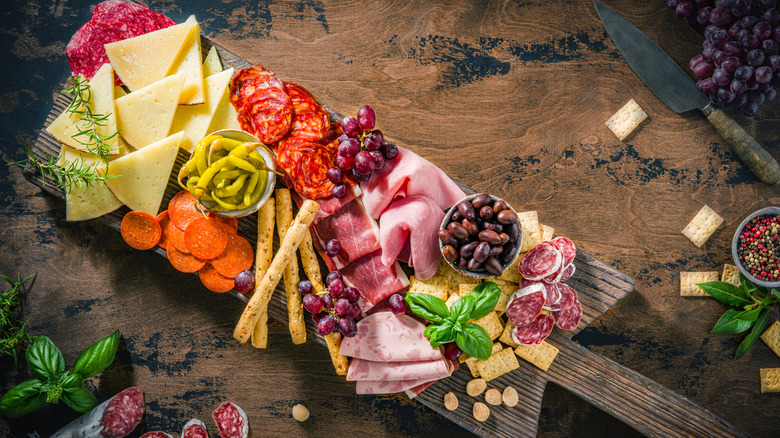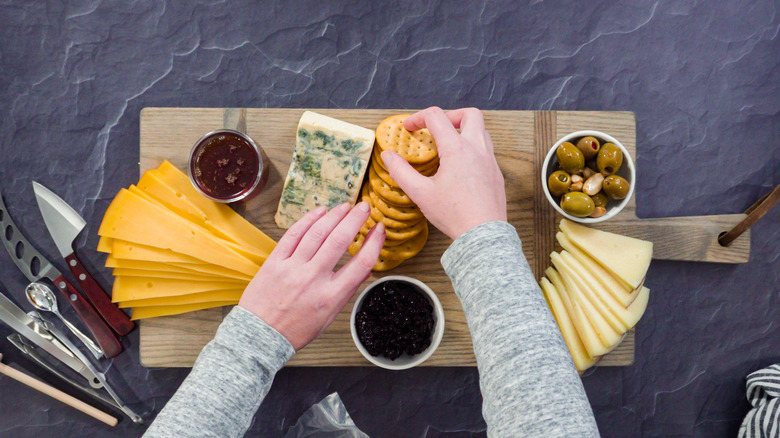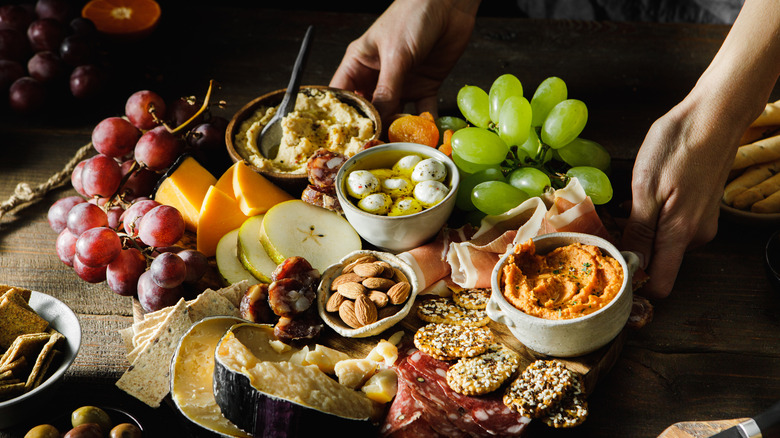The Golden Rule For Filling In Any Charcuterie Board
Ah, a stunning charcuterie. Who doesn't love the colorful grazing boards with cheese, meats, figs, and jam? The endless nibbles with sweet and savory components are a treat at any table. These days, charcuterie boards are Instagram-worthy works of art. From salami roses to perfectly triangle-cut cheese, it can be hard to figure out how to put one together.
Let's say you've gone to the grocery store and picked out your favorite ingredients. You even have a big board ready to build but where do you begin assembling it? The simple answer: Start by placing your larger treats on the board, like slices of bread and wheels of cheese, and then fill in the gaps with small ingredients like nuts and herbs. Visually, you want things to look pretty but you also want to make them easily accessible. When picking out meats and cheeses, keep their sizes in mind, and how you plan to cut or fold them. Most importantly, you're the artist of this creation so there are no hard and fast rules.
Big treats first
First, organize your ingredients. Then, look at how big your board is. You may want to cut up bigger ingredients into halves, so they don't take up a large portion of the board. Begin placing your largest ingredients on the board first. That may be jars of jam, a gooey double-cream cheese that cannot be pre-sliced, and large crackers. You can snake the crackers in a pretty swivel diagonally on the board and then build from there.
Now, go in with your smaller accouterments. Be sure to place them next to other ingredients that they'll pair well with. For example, Spanish olives are delicious with saltier cheese like cheddar, so be sure to place them closer together. Similarly, dried apricots pair well with softer cheeses like brie. You want to guide your guests through the board — a culinary road map, if you will — with pairings that work.
Next, scatter smaller treats like nuts and dried fruits throughout the board and use herbs as garnish pieces and aromatics. Rosemary is an excellent choice — it looks festive and can also be used as a honey stick. These smaller items will help fill in the blank bits of your board.
Build a board that hits all parts of the palate
As for what you should go on your board, think: salty, sweet, heat, acid, and fat — you want to excite all parts of your palate when filling up a charcuterie board. Cheese and meats tend to take care of the fatty bits. Pickled vegetables are a great way to add acidity to the board while filling up the smaller spaces. Think outside the box with ingredients like kimchi to add acidic and savory elements. You can roast your own nuts at home with different spice blends, including using chili flakes to add a bit of heat to the board. Dried and fresh fruits, honey, jam, and jellies add sweetness. Keep these different flavor components in mind when you're filling out your board. You want to try to have a balance of each flavor.
Small bowls of chutneys, toothpick holders, chocolate pieces, and breadsticks can also be used to fill in spaces on the board. You want to create a look of abundance for your guests, and all it takes is covering every bit of space on the board with thought-out treats. So, go ahead and paint — you charcuterie Picasso, you. And let your guests marvel at your masterpiece.


